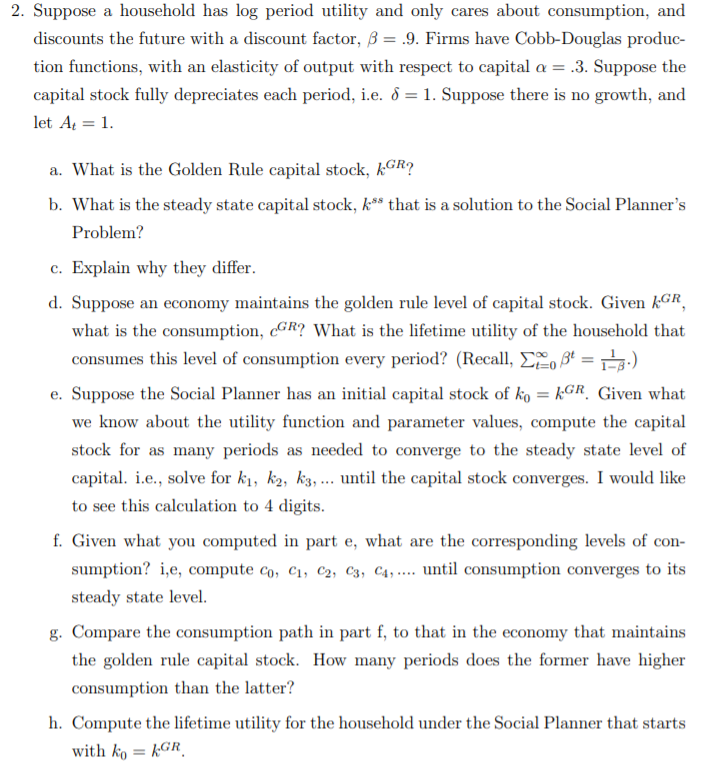
2. Suppose a household has log period utility and only cares about consumption, and discounts the future with a discount factor, B = .9. Firms have Cobb-Douglas produc- tion functions, with an elasticity of output with respect to capital a = .3. Suppose the capital stock fully depreciates each period, i.e. 8 = 1. Suppose there is no growth, and let At = 1. a. What is the Golden Rule capital stock, kGR? b. What is the steady state capital stock, k*s that is a solution to the Social Planner's Problem? c. Explain why they differ. d. Suppose an economy maintains the golden rule level of capital stock. Given kGR, what is the consumption, CGR? What is the lifetime utility of the household that consumes this level of consumption every period? (Recall, B4 = -3.) e. Suppose the Social Planner has an initial capital stock of ko = kGR. Given what we know about the utility function and parameter values, compute the capital stock for as many periods as needed to converge to the steady state level of capital. i.e., solve for ki, k2, k3, ... until the capital stock converges. I would like to see this calculation to 4 digits. f. Given what you computed in part e, what are the corresponding levels of con- sumption? i,e, compute Co, C1, C2, C3, C4, .... until consumption converges to its steady state level. g. Compare the consumption path in part f, to that in the economy that maintains the golden rule capital stock. How many periods does the former have higher consumption than the latter? h. Compute the lifetime utility for the household under the Social Planner that starts with ko = GR 2. Suppose a household has log period utility and only cares about consumption, and discounts the future with a discount factor, B = .9. Firms have Cobb-Douglas produc- tion functions, with an elasticity of output with respect to capital a = .3. Suppose the capital stock fully depreciates each period, i.e. 8 = 1. Suppose there is no growth, and let At = 1. a. What is the Golden Rule capital stock, kGR? b. What is the steady state capital stock, k*s that is a solution to the Social Planner's Problem? c. Explain why they differ. d. Suppose an economy maintains the golden rule level of capital stock. Given kGR, what is the consumption, CGR? What is the lifetime utility of the household that consumes this level of consumption every period? (Recall, B4 = -3.) e. Suppose the Social Planner has an initial capital stock of ko = kGR. Given what we know about the utility function and parameter values, compute the capital stock for as many periods as needed to converge to the steady state level of capital. i.e., solve for ki, k2, k3, ... until the capital stock converges. I would like to see this calculation to 4 digits. f. Given what you computed in part e, what are the corresponding levels of con- sumption? i,e, compute Co, C1, C2, C3, C4, .... until consumption converges to its steady state level. g. Compare the consumption path in part f, to that in the economy that maintains the golden rule capital stock. How many periods does the former have higher consumption than the latter? h. Compute the lifetime utility for the household under the Social Planner that starts with ko = GR







